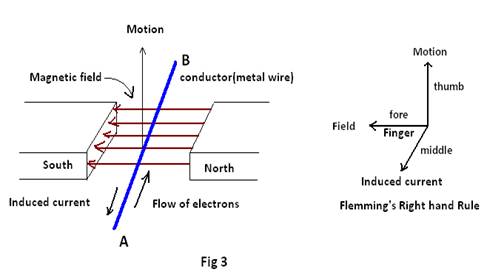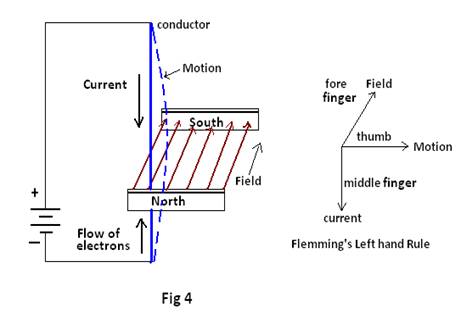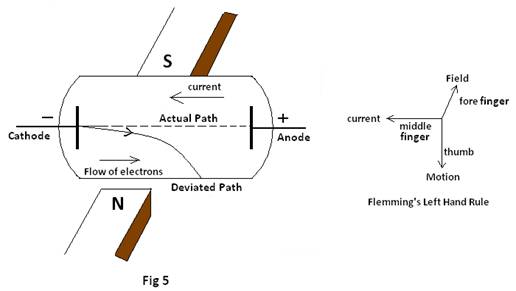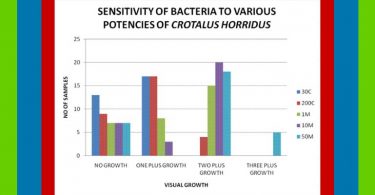The electromagnetic flow meter in medical science is a well developed device that can be used to measure blood flow in a blood vessel without opening it.The principle for such instrument is in accordance with generation of electromotive force in a wire that is moved rapidly through a magnetic field as per Faraday’s law of electromagnetic induction Fig 1. The said principle applies for generation of emf in blood when it moves through a magnetic field (i.e emf is induced in an electrical conductor having a relative motion to the magnetic field). In this case, a blood vessel is placed between the poles of a strong magnet, and electrodes are placed on the two sides of the vessel perpendicular to the magnetic lines of force Fig 2. When blood flows through the vessel, electrical voltage proportional to the rate of flow is generated between the two electrodes, and that is recorded by a suitable meter 1. The flow meter is even used for measuring flow of water or aqueous solutions through a pipe.
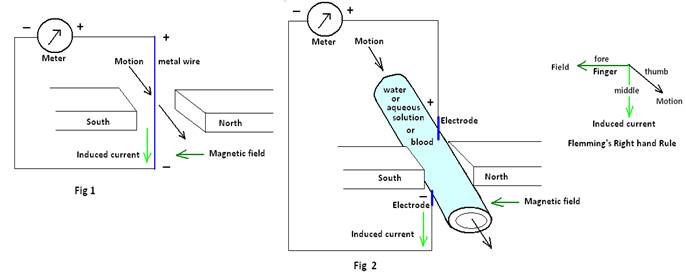
In the electromagnetic flow meter, the induced emf and hence induced current is directly proportional to the rate of flow of the water or the aqueous solution. Here we shall see whether the emf generated in the flow meter and the metal wire is only due to Faradays law of electromagnetic induction, or something else. Two separate experiments are performed, one with metal wire and other with distilled water as mentioned below, to note the generation of emf without application of any magnetic field:
Experiment 1: Six different pairs of electrodes are placed on a metal wire and emf for each pair is measured one after the other and recorded in table below.
| Sl.No. | Electrode Pairs | emf (in mV) |
| 1 | Gr—Cu | 0 |
| 2 | Gr—Zn | 0 |
| 3 | Gr—Pb | 0 |
| 4 | Pb—Zn | 0 |
| 5 | Cu—Pb | 0 |
| 6 | Cu—Zn | 0 |
Experiment 2: The above pairs of electrodes are immersed in distilled water and emf for each pair is measured one after the other and recorded in table below:
| Sl.No. | Electrode Pairs | emf (in mV) |
| 1 | Gr—Cu | 206 |
| 2 | Gr—Zn | 1023 |
| 3 | Gr—Pb | 660 |
| 4 | Pb—Zn | 432 |
| 5 | Cu—Pb | 302 |
| 6 | Cu—Zn | 770 |
Observations: From the above experiments it is clear that metal wire is not able to generate any emf in the absence of a magnetic field. It generates emf only when there is a relative motion between the metal wire and the magnetic field. But water (here distilled water is used) is able to generate sufficient emf, even in the absence of the magnetic field.
Discussions:
Generation of emf by a metal wire in the presence of a magnetic field, provided there is a relative motion between wire and the applied field, can be attributed solely to Faraday’s law of electromagnetic induction. Actually, when a metal wire is placed in the magnetic field, the induced emf hence induced current is produced, the direction of which in general is given by Lenz’s Law. However, the direction of the induced emf and hence induced current can be suitably obtained from Flemming’s right hand rule as shown below:
From above it is clear that a current (induced) flows through the metal wire in the direction B to A when it is placed in the magnetic field. It then shows that the flow of electrons must have taken place in the direction from A to B for generation of such induced emf and hence current. The question then arises, what makes the electrons in the conductor flow from A to B when subjected to the magnetic field? It seems electrons in the said conductor must have experienced some force due to the magnetic field .
It is well known that when a wire or conductor carrying an electric current is placed in the magnetic field of a magnet it experiences a mechanical force in the direction as per Flemming’s left hand rule:
Thus, the cathode rays consisting of electrons (beam /stream of electrons) are also seen to be deflected in the magnetic field and the deflection of electrons is strictly in accordance with Flemming’s left hand rule (as force experienced by a conductor carrying current in a magnetic field).
So when a metal conductor is placed in a magnetic field, the electrons (delocalized in metals) are deflected in a definite path following Flemming’s left hand rule. This deflection of electrons causes an imbalance of electrons in the conductor i.e; In fig 3 , “A” is relatively more electron dense than “B” at any given instant. The flow of electrons therefore occurs from the relatively denser end “A” (where deflected electrons accumulate), to the relatively lower concentration end “B” and constitute induced emf, hence induced current.
On the other hand generation of emf in case of water (in electromagnetic flow meter) cannot be specifically certified to be due to the Faraday’s law of electromagnetic induction as water can generate sufficient emf even in the absence of any magnetic field.
In the electromagnetic flow meter, the conductor is water, that when placed in a magnetic field is able to show induced current due to induced emf. The movement of electrons in a metal conductor (due to relative motion between metal conductor and magnet) generates induced emf, hence induced current. But, what generates induced current in water? It is believed that such generation of emf is due to the presence of ions in water. This suggests that ions, like electrons are also deflected in the magnetic field, thereby generating induced emf and hence induced current. Therefore, in water ions seems to flow from A to B, in lieu of electrons, while generating emf in the presence of a magnetic field. Further it implies that the difference in concentration of ions at A & B generates emf by pushing ions through the water. This shows that ions not only can move towards the opposite electrodes as in electrolysis, but also can move to the neutral electrodes for generating emf , as in the electromagnetic flow meter!
In other words, we can say that relative motion between the conductor (metal) and the magnetic field, pushes electrons through the metal wire in the case of the metal conductor, while it pushes ions in the case of water or aqueous solution with the generation of induced emf, hence induced current.
This now confirms that a conductor, whether it be metal, water or aqueous solution, generates induced emf only when there is a relative motion between it (the conductor) and the magnetic field.
This is true in the case of metal wire (as shown in experiment 1), where the metal wire fails to generate emf with the electrodes in the absence of the magnetic field, while the water generates sufficient emf with the electrodes (as shown in experiment 2) even in the absence of magnetic field.
The generation of emf in distilled water is not due to ions, which can be explained by the fact that the same distilled water generates different emf with the different pairs of electrodes4. Had the emf generation been due to ions, all pairs should have at least comparable emf, if not equal, but this is not the case. Actually, as ions neither conduct electrical energy in water2,3 , nor generate emf in distilled water or aqueous solution4, it is only the orientations of water molecules that conducts electrical energy and generates emf in an electromagnetic flow meter. Moreover, the relative motion between the water or aqueous solution and the magnetic field in an electromagnetic flow meter actually help re-orientation of water molecules and the generation of a resultant emf .
Inference : Distilled water or aqueous solution generates sufficient emf in the absence of an applied magnetic field due to the orientation of its molecules. So, in presence of any applied magnetic field, the resultant emf is nothing but the result of re-orientation of the water molecules.
Reference:
[1] Textbook of Medical Physiology (Twelfth Edition)(Reprinted 2012)-Guyton and Hall
[2] Solutions Ionic or Non-Ionic Conduct & Retain Electrical Energy Ruhul Amin & Biplab Chakraborty (Published in Homeopathy 4 Everyone July 2012. hpathy.com)
[3] The Key to Homeopathic Dilution, Ruhul Amin & Biplab Chakraborty (Published in Homeopathy 4 Everyone November 2012. hpathy.com)
[4] The Driving Force Behind Homeopathy – Explaining the Principle Behind the Generation of Emf in Water– Ruhul Amin & Biplab Chakraborty(Published in Homeopathy 4 Everyone November2013. hpathy.com)



